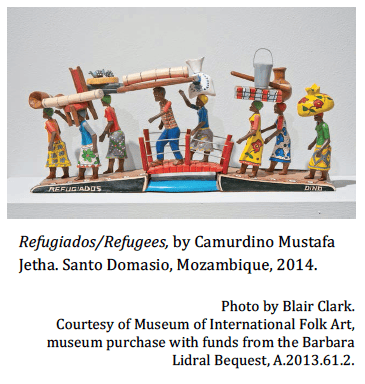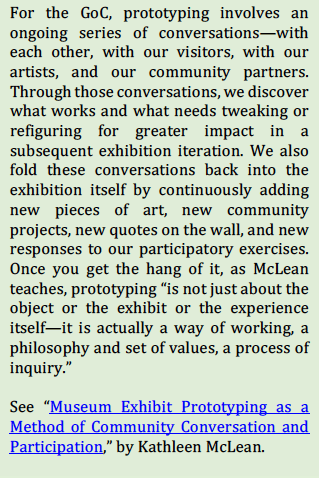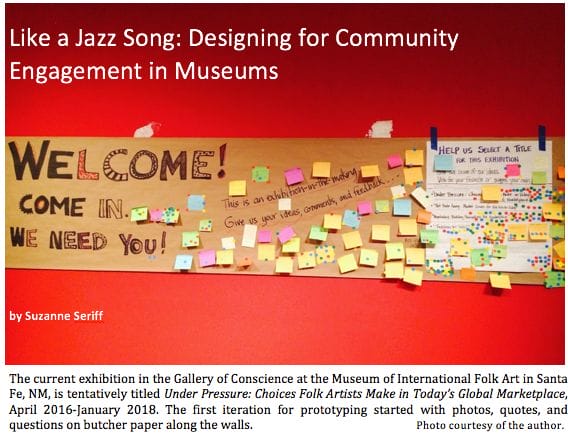Improvisation in jazz begins with a melodic phrase, invites a response, and builds on a theme. Sometimes melodic, sometimes cacophonous, the result is rooted in the magic of call and response, history in action. In 2012, the Museum of International Folk Art in Santa Fe, New Mexico incubated an improvisatory approach to exhibit development in its newly created Gallery of Conscience (GoC). Led by a team of folklorists, folk art educators, and design innovators, the results have been hailed “a model of museum practice for the 21st century.”1
Improvisation fits both the mission and the method of the GoC, which draws on the words and works of living traditional artists to catalyze dialogue, connect with communities, share stories across generations, and promote personal reflection, communication, and action around pressing issues of conscience important to us all. Like a jazz song, the exhibit development process begins with a single idea, explored through a limited set of artworks, like a melodic line in music. The first year of this new improvisatory approach in the gallery, the idea was HIV/AIDS and the ways folk artists use their art for education, advocacy, and awareness. On World AIDS Day 2012, a dozen or so works of art began the conversation in the gallery about folk artists’ responses to HIV/AIDS: a tower of 600 beaded dolls represented the children orphaned by AIDS in one South African village; an AIDS Memorial Quilt block commemorated eight New Mexicans who died at the height of the pandemic in the U.S; a carved wooden sculpture of an AIDS protest march in Mozambique’s capital challenged visitors to remain active against a pandemic that still affects more than 30 million men, women, and children worldwide.
Responding to the call over the coming days and months, community members, visitors, schoolchildren, families, and museum patrons added miniature protest signs, memorials to loved ones lost, radio pieces weaving artist stories with personal life stories, slogans to educate and enjoin, and squares sewn into a community quilt. Their improvisatory responses spoke of grief, resilience, activism and hope. They created an opening, an invitation to reflect upon, add their voices to, and discuss a topic too often hidden by silence, stigma, and misinformation. The result was sometimes beautiful, sometimes challenging, but always rooted in the community’s call to respond.
 Folk art proved to be a compelling catalyst for this kind of honest conversation about a global health pandemic spanning generations, cultures, geographies, and histories. As folklorists, we know the value of traditional, familiar, hence readily understandable forms of storytelling to reach people, and how these stories effectively transcend the barriers of language, taboo, religion, or race. Meaningful, heartfelt, and sometimes controversial conversations were effectively sparked by the artworks themselves, the words and passions of their creators, and the participatory environment we created in the space.
Folk art proved to be a compelling catalyst for this kind of honest conversation about a global health pandemic spanning generations, cultures, geographies, and histories. As folklorists, we know the value of traditional, familiar, hence readily understandable forms of storytelling to reach people, and how these stories effectively transcend the barriers of language, taboo, religion, or race. Meaningful, heartfelt, and sometimes controversial conversations were effectively sparked by the artworks themselves, the words and passions of their creators, and the participatory environment we created in the space.

The second exhibition in the newly re-focused GoC centered on the topic of immigration and the overarching issues of living between two worlds and struggling to belong in a place that is not always welcoming. The exhibit opened in the winter of 2014, when national news headlines featured stories of tens of thousands of women and children—most seeking asylum from conditions of life-threatening violence in their home countries—who had crossed the border into the U.S. and were being held in newly opened, privately run, detention centers in New Mexico and Texas. Several of the artworks uncannily mirrored the very current events in the national news, even though they had been created years before.
Two of the most evocative artworks included a painting by Cuban artist Cenia Guttiérez Alfonso depicting an unaccompanied young girl crossing the Atlantic Ocean on her journey to a new land, and a three-part sculpture by Peruvian American retablo maker Nicario Jiménez (provocatively titled Immigration: The American Dream), which illustrates the differential receptions of three groups of undocumented Latino families arriving on our nation’s shores—Cubans, Haitians, and Mexicans—by refugee assistance agencies, detention centers, and border police, respectively. Also, putting the immigration crisis in global perspective, a painted wood sculpture by Mozambican folk artist Camurdino Mustafa Jetha depicted a group of refugiados—refugees from the decades-long civil war in his country—marching single file toward asylum with their barest necessities balanced on their heads. 
Artworks addressed four main themes, based on input from community members and advisors: Deciding to Leave, Dangerous Journeys, Who Belongs?, and Where Is My Home? Each was highlighted by a first-person quote from community members taped on the gallery walls:2
 And the participatory exercises set up throughout the gallery intentionally encouraged visitors—especially young visitors—to put themselves in newcomers’ shoes:
And the participatory exercises set up throughout the gallery intentionally encouraged visitors—especially young visitors—to put themselves in newcomers’ shoes:
If you had to leave your home and could only bring what you could carry, what would it be?
Describe a time when you felt that you didn’t belong. Use the Post-its or tweet your response at @galleryofconscience.
Even the exhibition title, Between Two Worlds: Folk Artists Reflect on the Immigrant Experience, was the result of a crowd-sourced contest to pick the title that best reflected the questions “Who Belongs?” and “Who Can Be an American?” These are the questions that have always been at the heart of the immigration debate in our nation—and are with us in the national and international news today.

 Community Engagement and the Museum Exhibition Design Process
Community Engagement and the Museum Exhibition Design Process
For the Gallery of Conscience, the motivation to incubate an entirely new design process was to create a “medium” that fundamentally mirrored the “message.” Like social justice work itself, we wanted a process that was responsive, responsible, collaborative, engaged, equitable, impactful, and ethically motivated. From our first exhibition in 2012, to the third exhibition prototyped in the GoC in the spring of 2016, this museum space builds and expands on our commitment to exploring social justice themes and issues through the lens of folk art.
For such a conceptual overhaul to be successful and embraced, we knew the audience and local communities needed to gain a sense of ownership through active involvement, not passive lectures. Everyone has something to offer. If we wanted to tap that collaborative vein, we had to clean our own house by shaking up the conventional museum decision-making structure. So we began by throwing out the curator/ designer/educator model of exhibit expertise in favor of a team approach that was fundamentally collaborative, improvisational, and flexible. Focusing on audience engagement rather than specialized knowledge, this team-based approach represented, for us, a more innovative structure designed for visitors to learn through doing. Rather than dividing ourselves into distinct roles within the team, we all worked together within the gallery to design the spaces, engage the visitors, create the interactives, write the labels, conduct visitor evaluations, and change and adjust the prototyped space for increased clarity and depth of response, after each iteration. Our goal was to be as nimble and responsive with each other as we hoped to be with our visitor and community input.
While our core team of folklorists and museum professionals was experienced in community-based collaborations, we had little collective experience in a truly bottom-up, participatory and dialogic model of exhibit development. This is where Kathy McLean’s experience and expertise came in as our resident “prototyping guru.” McLean explains her idea of prototyping—drawn from the Greek word meaning “first impressions”—as “a mock-up or a quick and dirty version of an idea; something flexible and changeable; a tool for learning something about the effects of an idea or object on the end-user…and in the case of museums, the relevance of an exhibit or experience on the museum visitor.”3
The result has been both exhilarating and exasperating.
Challenges have arisen in defining exactly what we mean by community involvement and what we mean by “art”; managing workflow expectations and responsibilities; communicating the value of work-in-progress to patrons, who expect finished products; ceding the conventional authority of curator and designer; and redefining success in new terms—based more on reaching new audiences than on pleasing old patrons, and on starting conversations, rather than on creating polished exhibits.
While initially skeptical of such an improvisatory, inclusive model of museum engagement, we are all beginning to recognize the revolutionary potential of this kind of “crowd-sourcing” approach to engaging local and global audiences in the co-creation of their learning, sharing, marketing, and advocating experiences around issues of real relevance, yet distinct differences, in each of their communities and lives. And responses from visitors, community participants, and participating artists reinforce our enthusiasm:
~I saw myself here for the first time. Thank you for that…
~I love that the gallery is always changing, and is changed by the people who have responded….
~This is a brave thing to do….
~This is a beautiful exhibit—accessible in ways museums haven’t felt before.
~There should be a place in every museum where you have to commit your own opinions. More museums should get a hold of people emotionally, not just intellectually.
~This is an excellent and timely exhibit. It brings awareness and helps people empathize by putting them in others’ shoes.
Together, museums and communities have the potential to create an entirely new and replicable model for civic engagement that finds its way back to what community-based artists and storytellers have known all along. In the words of master bead worker, Lulama Sihlabeni of South Africa, “Folk art must speak to people—that is part of what puts the ‘folk’ in folk arts!”
Suzanne Seriff received her PhD in Folklore and Ethnomusicology at the University of Texas at Austin, where she currently teaches courses on folk arts and community engagement, museum innovation, cultural heritage production, and immigration in the Department of Anthropology. She also has worked, since 2010, as curator and more recently, director of the Gallery of Conscience at the Museum of International Folk Art in Santa Fe.
Read the full series featuring The Gallery of Conscience: A gallery director, a community engagement collaborator, and a classroom teacher examine the profound implications of opening museum exhibitions about contemporary, controversial issues to public and student co-curation. The projects involve folk artists and folklore’s ethnographic tools to create a participatory space to learn about an issue from multiple perspectives, with the possible outcome of fostering empathy and understanding. (Gallery of Conscience Section pdf here)
You just read: Like a Jazz Song: Designing for Community Engagement in Museums by Suzanne Seriff
Up next: Between Two Worlds: A Collaborative Curriculum Addressing Immigration through Folk Art, Media Literacy, and Digital Storytelling by Laura Marcus Green with Katy Gross and Tara Trudell
Learning Application: Tips for Adapting a Collaborative Curriculum in Classrooms or Museums
Learning Application: Collaborative Curriculum Introductory Lesson Plan
Project-Based Learning: Elementary Students as Researchers of Immigration Narratives by Natasha Agrawal
Endnotes
- Gretchen Jennings, “Critique of Between Two Worlds.” Exhibition Critique Section of AAM’s Exhibitionist Journal, Spring 2015: 71.
- Quotes in order of their presentation (left to right, top to bottom) by: Helga Ancona, Brazilian, KSFR radio program host, Santa Fe; National Dialogues on Immigration participant; Kamajou Tadfor, Cameroonian, artistic director, Afreeka Santa Fe and producer, Fiesta Fela; Catalina Delgado Trunk, papel picado artist, Albuquerque
McLean, Katheen. “Museum Exhibit Prototyping as a Method of Community Conversation and Participation.” Professional Development Report of the American Folklore Society. www.afsnet.org/?page=ConsProfDev.
For an expanded version of this article, see two forthcoming book chapters from which this article was largely excerpted: “Immigration, Empathy, and Engagement: Incubating a New Approach to Immigration in the Museum of International Folk Art’s Gallery of Conscience,” in Interpreting Immigration; Connecting Past and Present at Museums, ed. Sarah Pharaon. Forthcoming 2017. Nashville: AASLH Press. And “Like a Jazz Song: A New Model for Social Justice Work in a Museum Setting: The Case of the Gallery of Conscience at the Museum of International Folk Art,” by Suzanne Seriff and Marsha Bol in Folklife and Museums: 21st Century Perspectives, eds. Charlie Seemann, Patricia Hall, and C. Kurt Dewhurst. Lanham: Rowman and Littlefield. Forthcoming 2016.

